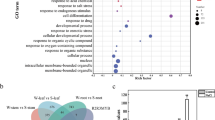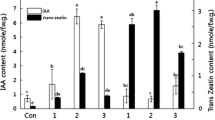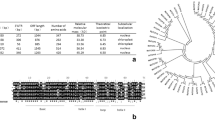Abstract
Transcription factors regulating the stress-responsive gene expression play an important role in plant stress adaptation. In this study, we examined the salt stress tolerance of transgenic Virginia pine (Pinus virginiana Mill.) overexpressing a Capsicum annuum ERF/AP2-type transcription factor (CaPF1), which may enhance the ability of transgenic plants to tolerate various kinds of stresses during vegetative growth. CaPF1 transgene increased the salt and oxidative stress tolerances of pine tissues and counteracted the inhibitory effects of salt stress on the growth of transgenic Virginia pine calli, shoots, and plants. To our surprise, the ability of shoot formation was enhanced in three CaPF1 transgenic Virginia pine cell lines under stress of different NaCl concentrations. NaCl at 200 mM significantly increased the frequency of adventitious shoot formation and the number of shoots per gram calli. Measurement of plant hormone demonstrated that the levels of cytokinin was altered in CaPF1-overexpressed Virginia pine calli, compared to the control. Based on our results, we speculate that the altered level of cytokinin may result in enhancing adventitious shoot formation of transgenic calli exposed to salt for 1 week via an unknown mechanism.







Similar content being viewed by others
References
Apse MP, Aharon GS, Snedden WA, Blumwald E (1999) Salt tolerance conferred by overexpression of a vacuolar Na+/H+ antiporter in Arabidopsis. Science 285:1256–1258
Bohnert HJ, Nelson DE, Jensen RG (1995) Adaptations to environmental stresses. Plant Cell 7:1099–1111
Borsani O, Valpuesta V, Botella MA (2001) Evidence for a role of salicylic acid in the oxidative damage generated by NaCl and osmotic stress in Arabidopsis seedlings. Plant Physiol 126:1024–1030
Busk PK, Pages M (1998) Regulation of abscisic acid-induced transcription. Plant Mol Biol 37:425–435
Chaudhury AM, Letham S, Craig S, Dennis ES (1993) amp1-a mutant with high cytokinin levels and altered embryonic pattern, faster vegetative growth, constitutive photomorphogenesis and precocious flowering. Plant J 4:907–916
Chen WQ, Provart NJ, Glazebrook J, Katagiri F, Chang HS, Eulgem T, Mauch F, Luan S, Zou GZ, Whitham SA, Budworth PR, Tao Y, Xie ZY, Chen X, Lam S, Kreps JA, Harper JF, Si-Ammour A, Mauch-Mani B, Heinlein M, Kobayashi K, Hohn T, Dangl JL, Wang X, Zhu T (2002) Expression profile matrix of Arabidopsis transcription factor genes suggests their putative functions in response to environmental stresses. Plant Cell 14:559–574
Deshnium P, Los DA, Hayashi H, Mustardy L, Murata N (1995) Transformation of Synechococcus with a gene for choline oxidase enhances tolerance to salt stress. Plant Mol Biol 29:897–907
Dezar CA, Gago GM, Gonzalez DH, Chan RL (2005) Hahb-4, a sunflower homeobox-leucine zipper gene, is a developmental regulator and confers drought tolerance to Arabidopsis thaliana plants. Transgenic Res 14:429–440
Dobrev PI, Kaminek M (2002) Fast and efficient separation of cytokinins from auxin and abscisic acid and their purification using mixed-mode solid-phase extraction. J Chromatogr A 950:21–29
Jaglo-Ottosen KR, Gilmour SJ, Zarka DG, Schabenberger O, Thomashow MF (1998) Arabidopsis CBF1 overexpression induces COR genes and enhances freezing tolerance. Science 280:104–106
Johnson DW, Smith SE, Dobrenz AK (1992) Genetic and phenotypic relationships in response to NaCl at different developmental stages in alfalfa. Theor Appl Genet 83:833–838
Kasuga M, Liu Q, Miura S, Yamaguchi-Shinnozaki K, Shinozaki K (1999) Improving plant drought, salt, and freezing tolerance by gene transfer of a single stress-inducible transcription factor. Nat Biotechnol 17:287–291
Kim JB, Kang JY, Kim SY (2004) Over-expression of a transcription factor regulating ABA responsive gene expression confers multiple stress tolerance. Plant Biotechnol J 2:459–466
Klee H, Romano CP (1994) The roles of phytohormones in development as studied in transgenic plants. Crit Rev Plant Sci 13:311–324
Kovtun Y, Chiu WL, Tena G, Sheen J (2000) Functional analysis of oxidative stress-activated mitogen-activated protein kinase cascade in plants. Proc Natl Acad Sci USA 97:2940–2945
Lauchli A, Epstein E (1990) Plant responses to saline and sodic conditions. In: Tanji KK (eds) Agricultural salinity assessment and management. American Society of Civil Engineering, New York, pp 113–137
Leon-Kloosterziel KM, Gil MA, Ruijs GJ, Jacobsen SE, Olszewski NE, Schwartz SH, Zeevaart JA, Koornneef M (1996) Isolation and characterization of abscisic acid-deficient Arabidopsis mutants at two new loci. Plant J 10:655–661
Lichtenthaler HK (1987) Chlorophyll and carotenoids: pigments of photosynthetic biomembranes. Methods Enzymol 18:350–382
Liu Q, Kasuga M, Sakuma Y, Abe H, Miura S, Yamaguchi-Shinozaki K, Shinozaki K (1998) Two transcription factors, DREB1 and DREB2, with an EREBP/AP2 DNA binding domain separate two cellular signal transduction pathways in drought- and low temperature-responsive gene expression, respectively, in Arabidopsis. Plant Cell 10:1391–1406
Moon H, Lee B, Choi G, Shin D, Prasad DT, Lee O, Kwak SS, Kim DH, Nam J, Bahk J, Hong JC, Lee SY, Cho MJ, Lim CO, Yun DJ (2003) NDP kinase 2 interacts with two oxidative stress-activated MAPKs to regulate cellular redox state and enhances multiple stress tolerance in transgenic plants. Proc Natl Acad Sci USA 100:358–363
Munns R (2005) Genes and salt tolerance: bringing them together. New Phytol 167:645–663
Munns R, James RA, Lauchli A (2006) Approaches to increasing the salt tolerance of wheat and other cereals. J Exp Bot 57:1025–1043
Murata N, Ishizaki-Nishizawa O, Higashi S, Hayashi H, Tasaka Y, Nishida I (1992) Genetically engineered alteration in the chilling sensitivity of plants. Nature 356:710–713
Nakamura T, Yokota S, Muramoto Y, Tsutsui K, Oguri Y, Fukui K, Takabe T (1997) Expression of a betaine aldehyde dehydrogenase gene in rice, a glycinebetaine nonaccumulator, and possible localization of its protein in peroxisomes. Plant J 11:1115–1120
Oh SK, Park JM, Joung YH, Lee S, Chung E, Kim SY, Yu SH, Choi D (2005) A plant EPF-type zinc-finger protein, CaPIF1, involved in defence against pathogens. Mol Plant Pathol 6:269–285
Pasternak D (1987) Salt tolerance and crop production: a comprehensive approach. Annu Rev Phytopathol 25:271–291
Romano CP, Hein MB, Klee HJ (1991) Inactivation of auxin in tobacco transformed with the indoleacetic acid- lysine synthetase gene of Pseudomonas savastanoi. Genes Dev 5:438–446
Roxas VP, Smith RK Jr, Allen ER, Allen RD (1997) Overexpression of glutathione S-transferase/glutathione peroxidase enhances the growth of transgenic tobacco seedlings during stress. Nat Biotechnol 15:988–991
Sakamoto A, Murata N (2002) The role of glycine betaine in the protection of plants from stress: clues from transgenic plants. Plant Cell Environ 25:163–171
Sakuma Y, Liu Q, Dubouzet JG, Abe H, Shinozaki K, Yamaguchi-Shinozaki K (2002) DNA-binding specificity of the ERF/AP2 domain of Arabidopsis DREBs, transcription factors involved in dehydration- and cold-inducible gene expression. Biochem Biophys Res Commun 290:998–1009
Seki M, Kamei A, Yamaguchi-Shinozaki K, Shinozaki K (2003) Molecular responses to drought, salinity and frost: common and different paths for plant protection. Curr Opin Biotechnol 14:194–199
Sheveleva E, Chmara W, Bohnert HJ, Jensen RG (1997) Increased salt and drought tolerance by D-ononitol production in transgenic Nicotiana tabacum L. Plant Physiol 115:1211–1219
Shi H, Lee BH, Wu SJ, Zhu JK (2003) Overexpression of a plasma membrane Na+/H+ antiporter gene improves salt tolerance in Arabidopsis thaliana. Nat Biotechnol 21:81–85
Sulpice R, Tsukaya H, Nonaka H, Mustardy L, Chen THH, Murata N (2003) Enhanced formation of flowers in salt-stressed Arabidopsis after genetic engineering of the synthesis of glycine betaine. Plant J 36:165–176
Tang W, Newton RJ (2005) Polyamines reduce salt-induced oxidative damage by increasing the activities of antioxidant enzymes and decreasing lipid peroxidation in Virginia pine. Plant Growth Reg 46:31–43
Tang W, Luo H, Newton RJ (2004) Effects of antibiotics on the elimination of Agrobacterium tumefaciens from loblolly pine (Pinus taeda) zygotic embryo explants and on transgenic plant regeneration. Plant Cell Tiss Org Cult 70:71–81
Tang W, Charles TM, Newton RJ (2005a) Overexpression of the pepper transcription factor CaPF1 in transgenic Virginia pine (Pinus virginiana Mill.) confers multiple stress tolerance and enhances organ growth. Plant Mol Biol 59:603–617
Tang W, Peng XX, Newton RJ (2005b) Enhanced tolerance to salt stress in transgenic loblolly pine simultaneously expressing two genes encoding mannitol-1-phosphate dehydrogenase and glucitol-6-phosphate dehydrogenase. Plant Physiol Biochem 43:139–146
Tantikanjana T, Yong JW, Letham DS, Griffith M, Hussain M, Ljung K, Sandberg G, Sundaresan V (2001) Control of axillary bud initiation and shoot architecture in Arabidopsis through the SUPERSHOOT gene. Genes Dev 15:1577–1588
Tarczynski MC, Jensen RG, Bohnert HJ (1993) Stress protection of transgenic tobacco by production of the osmolyte mannitol. Science 259:508–510
Vinocur B, Altman A (2005) Recent advances in engineering plant tolerance to abiotic stress: achievements and limitations. Curr Opin Biotechnol 16:123–132
Xiong L, Schumaker KS, Zhu J-K (2002) Cell signaling during cold, drought, and salt stress. Plant Cell 14(Suppl):S165–S183
Yamaguchi-Shinozaki K, Shinozaki K (1994) A novel cis-acting element in an Arabidopsis gene is involved in responsiveness to drought, low-temperature, or high-salt stress. Plant Cell 6:251–264
Yi SY, Kim JH, Joung YH, Lee S, Kim WT, Yu SH, Choi D (2004) The pepper transcription factor CaPF1 confers pathogen and freezing tolerance in Arabidopsis. Plant Physiol 136:2862–2874
Zeevaart JAD, Creelman RA (1988) Metabolism and physiology of abscisic acid. Annu Rev Plant Physiol Plant Mol Biol 39:439–473
Zhu JK (2002) Salt and drought stress signal transduction in plants. Annu Rev Plant Biol 53:247–273
Zhu J, Verslues PE, Zheng X, Lee BH, Zhan X, Manabe Y, Zhu Y, Dong CH, Zhu JK, Hasegawa PM, Bressan RA (2005) HOS10 encodes an R2R3-type MYB transcription factor essential for cold acclimation in plants. Proc Natl Acad Sci USA 102:9966–9971
Acknowledgements
The authors are grateful to Dr. D. Choi for the gift of the vector pMBP-1-CaPF1, and to undergraduate research assistants Ambrosia Yarn, Oghale Asagbra, Zalak Daftary, Nicki Whitley, and Tinya DeLaGarza, for their work in isolating mature embryos for callus induction. We thank Mr. H. Wang and Dr. C. Li for the assistance in the experiment of phytohormone measurement. This work was supported by the East Carolina Christmas Tree Program.
Author information
Authors and Affiliations
Corresponding author
Additional information
Communicated by J.-K. Zhu
Rights and permissions
About this article
Cite this article
Tang, W., Newton, R.J., Lin, J. et al. Expression of a transcription factor from Capsicum annuum in pine calli counteracts the inhibitory effects of salt stress on adventitious shoot formation. Mol Genet Genomics 276, 242–253 (2006). https://doi.org/10.1007/s00438-006-0137-5
Received:
Accepted:
Published:
Issue Date:
DOI: https://doi.org/10.1007/s00438-006-0137-5




